Ten years ago, I stood on a dive platform above the Great Detached Reef in the far north of Australia. We had departed from Cairns, the portal to the best tropical diving in Queensland, and dived some of the Great Barrier Reef’s most iconic sites along the Ribbon Reefs, including Pixie Pinnacle, the Cod Hole and others. But instead of returning to Cairns, we kept cruising north to visit remote sites divers rarely reach. Unfortunately, the captain soon reported the approach of heavy weather: Cyclone Guba was headed in our direction. It had already taken 149 lives in nearby Papua New Guinea and was not to be trifled with. We hastily evacuated, leaving the far north for another day.
That other day came in November 2017. It was the kind of project I had to plan well in advance to make happen. With only a few liveaboards serving the region and the cruising season being only a few months long, there were not a lot of options for a whole-boat charter. I booked the liveaboard for the expedition two years before our scheduled departure. During that time the Great Barrier Reef (GBR) was in the news, and the reason was not good.
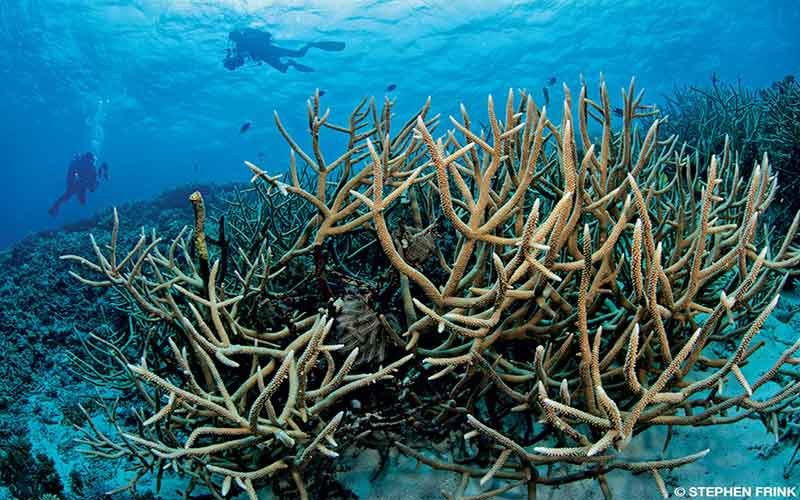
The water was especially warm in the summer of 2016, and the corals were bleaching. The GBR was only one of many reefs around the world suffering coral bleaching, and this was not the first time divers were seeing large amounts of hard corals turned white from the expulsion of their symbiotic algae (zooxanthellae). (To learn more about coral bleaching, see AlertDiver.com/Chasing_Coral and AlertDiver.com/Coral_Bleaching_Coral_Mortality.)
As those articles explain, bleached corals are stressed but not necessarily dead. Favorable changes in water temperature, salinity, turbidity or whatever factor caused the stress can allow the reef to recover. Despite that reality, the editorial coverage that seemed to most influence public perception of the GBR’s health was its obituary in Outside magazine in October 2016, a bit of satire that went viral. The article was wry and clever, and it addressed real issues of climate change, ocean acidification and the vulnerability of our coral reefs. But people should never have interpreted these words as literally as some readers did:
The Great Barrier Reef of Australia passed away in 2016 after a long illness. It was 25 million years old. For most of its life, the reef was the world’s largest living structure and the only one visible from space. It was 1,400 miles long, with 2,900 individual reefs and 1,050 islands. In total area, it was larger than the United Kingdom, and it contained more biodiversity than all of Europe combined. It harbored 1,625 species of fish, 3,000 species of mollusk, 450 species of coral, 220 species of birds, and 30 species of whales and dolphins. Among its many other achievements, the reef was home to one of the world’s largest populations of dugong and the largest breeding ground of green turtles.

and gorgonian complementing the prolific branching corals.
It should come as no surprise that hyperbole is common parlance on the World Wide Web, and the death of the GBR was widely believed to be true.
I was pretty certain we would not spend our 2017 Australia dive adventure documenting a deceased and “past-tense” ecosystem, but I will admit to some uncertainty about what we might see. We intended to travel north toward the equator, where warm water could be even more of a concern than it might be at the southern tip of the reef, 1,400 miles away. We were to be one of the first groups to visit after the waters had seasonally cooled and the corals, we hoped, had a chance to bounce back.
I can’t speak about the entire 133,000 square miles of the GBR, nor can I attach scientific weight to what we saw, but we observed and documented extraordinarily healthy coral reefs. If there had been bleaching at the sites we visited, the rejuvenation was inspirational. And we were certainly not the only visitors in the fall of 2017 to have that observational experience of the reef.
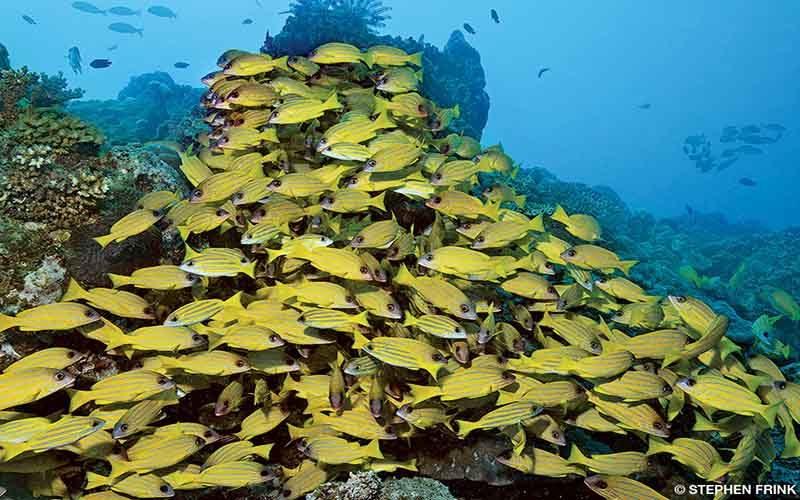
A few weeks after our trip, a group of scientists undertook the Great Barrier Reef Legacy expedition, a research survey of many of the same reefs we dived. When the scientists landed on Horn Island at the end of their trip, a reporter asked expedition coordinator Dean Miller, Ph.D., his impressions of the reefs. It is telling that the media was waiting; with so much bad press about the health of the GBR, inquiring minds wanted to know the truth. Miller stated:
“We’ve all been pleasantly surprised and kind of blown away by the quality, diversity and health of the outer reef sites. We’ve seen some fantastic reefs and expanses of coral. Look, we didn’t know what to expect. The aerial surveys let us know that the inshore and mid-shelf reefs were quite impacted, but I guess the outer reef was a bit of an unsolved story.… It is showing us that the resilience and rehabilitative properties of reefs is still going on, which is really, really important.”
The Far North
We steamed 140 miles on our first night, departing from Cairns and headed toward the northern part of the Ribbon Reefs. Our first dive, on Princess Reef, was a little underwhelming in terms of marine life, but sighs of relief bubbled through 24 regulators as we swam amid a reef complex decorated by pristine staghorn and various other branching corals. Many of the Indo-Pacific coral species were unfamiliar to me, and the reefs were vast, intact and anything but white. I understand they might have been previously bleached, but we saw scant evidence of that.

Our next dive was at Lighthouse Bommie, one of several popular pinnacles in the region. Rising from around 100 feet to within 16 feet of the surface, this coral chimney is notable for the large school of bluelined snapper resident at its base and the large school of bigeye trevally that swims in the midwater. Green turtles are exceedingly common here, especially in the late afternoon and evening as they find safe crannies in the pinnacle in which to rest for the night. Over the years I have often dived the pinnacles of the northern Ribbon Reefs, including Pixie Pinnacle and Steve’s Bommie. This time I saw weather damage that I had not seen in years past. Many cyclones had swept these waters in the preceding years, affecting the soft corals. They are the first and fastest to regenerate, and I saw signs of new growth.
Our next dive featured some of the most charismatic fish in Australia. We were at the Cod Hole, perhaps the most famous GBR dive site. As I geared up, my mind wandered to another time: a trip to South Australia with Ron and Valerie Taylor in the early 1990s. Ron was Australia’s premiere filmmaker, and Valerie was a renowned underwater photographer, model and marine conservationist. We were waiting for great white sharks to show interest in our chum line, and we had a lot of time to talk about dive adventures gone by. Valerie brought up the subject of potato cod (Epinephelus tukula), recalling how critically threatened they once were. Bold and inquisitive, they would swim right up to divers, oblivious to the presence of spear guns. They were so fearless that their survival as a species in Australian waters was in peril. Through Valerie’s photos and impassioned words, even nondivers in government were made to believe in the value of these fish, and now throughout most of their range in Australian waters it is illegal to spear them. The site that benefits most from this protection is the Cod Hole, located on Ribbon Reef #10.

In the decade since I had last dived the Cod Hole, the coral had been damaged, but by cyclones rather than coral bleaching or diver contact. This was no surprise, as an average of four cyclones affect Australia’s east coast every year. With such significant coral cover in less than 60 feet of water, big waves can take a toll. This dive is more about the marine life than coral cover anyway: The site’s namesake grouper, which can be 6 feet long and 200 pounds or more, are long accustomed to interacting with divers (in hopes of handouts).
We did two dives on this site; on the second one, I got in before the divemaster. The potato cod were there when I entered the water, but they were distant and indifferent. When the guide hit the water, the presence of the bait-bucket changed everything, and the potato cod quickly approached. With that I saw how thoroughly classically conditioned these fish had become. I would not say this was a fish-feeding dive so much as it was a fish-attracting dive, as there was not a lot of bait actually fed to the fish. Apparently their atavistic memories conjured “diver equals free food,” and thus achieving proximity was never an issue.
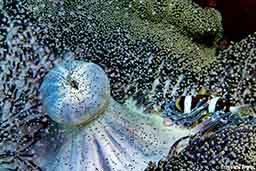
We steamed 162 miles overnight on our northward trajectory. We reached Bisou Point in the Tijou Reef region, which represented our arrival in the “far north.” Had I not been preconditioned to worry about the health of the coral I might not have been so obsessive about photographing every bit of staghorn and antler coral we encountered, but after a couple of dives we were thoroughly reassured about the health of the reef. Our anxiety was gone, replaced by the easy pleasure of fine diving. There were vast fields of coral, but curiously a few smaller areas had been absolutely pummeled. If I had been in Indonesia I would have wondered if it were the result of dynamite fishing, but I think it was just the product of wave action on shallow areas. For the most part, this was a gorgeous reef complex.
Our schedule brought us to the far north at the right time in the lunar cycle for a coral spawn. We had to decide whether to stay at anchor for the night dive or leave early to get to iconic Raine Island for an early-morning dive along its southern wall at a spot called Turtle Soup. The crew anticipated high winds later in the day that might make the site difficult to dive. The diving had to be done from a live mothership due to navigation restrictions near the island, which were in place to protect sea turtles. We opted for the early departure to maximize our access to Raine Island. The first time I heard about Raine I was reading National Geographic. As I entered the water, David Doubilet’s description was in my mind’s eye:
Raine … is the jewel of the reef. Every other year it hosts 80,000 green turtles that come to mate and crawl on the island and lay eggs. I went with a scientist who had a permit to work there and swam with hundreds of turtles that moved like underwater clouds. They seemed to appear and disappear because they blend in perfectly with the surrounding reef. Such numbers in one small place makes them very vulnerable. Ten thousand plus turtles would pull themselves ashore at night. It was the Times Square of green sea turtles. As dawn broke, the last females were pulling themselves toward the sea. The island was covered in tracks that looked like a massive amphibious landing. I have never seen anything like it.
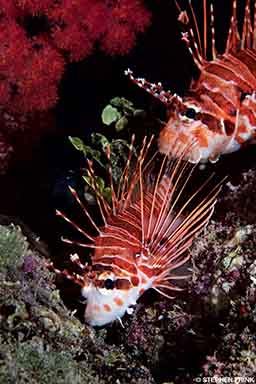
Perhaps we got there a bit late; we saw the tracks Doubilet described and some turtles on the beach, but only a few turtles were in the spur and groove formations underwater. Some of us were lucky enough to also see the animal that preys on the turtles: the tiger shark. You will find other sites that offer better coral cover and more diverse fish populations than Raine, but its concentration of sea turtles cannot be beat. Weather and timing are important with this site — sometimes the turtles are not there en masse, but when they are, it is astonishing.
We cruised overnight to the Great Detached Reef for a morning dive at Perisher Blue. I remember this site from a decade before, primarily because of the truly astonishing visibility we had that day. It was pretty good the second time, but the blustery winds that dictated our schedule around Raine Island made the water a little fuzzy. It was not so bad, however, that we were not thoroughly inspired by the site’s staghorn colonies.
I know I go on and on about staghorn. It is not only because we had been led to believe they were dead here, and they were not; it is also because really good staghorn is rare everywhere these days. I am a Key Largo, Fla., guy, and when I came to town in 1978 the whole of South Carysfort Reef was cloaked in staghorn and elkhorn. For whatever reason, mostly because I thought it would be like that forever, I never got around to properly documenting those corals before they were gone. Now whenever I see amazing coral like that, I am happy to invest time in photographic coverage. We are in an era in which pixels might last longer than polyps, and I want to see and record all that I can.
The afternoon and night dives were at a spot simply called The Pinnacle. This one had more soft corals and other colorful filter feeders than we had seen elsewhere, and these made for great wide-angle photos with divers and environmental portraits with extravagant backgrounds. One particular overhang, draped with red sea fans and soft corals and rich with coral grouper, seemed emblematic of the site. What really blew me away was the night dive here.
Stepping off the swim platform and dropping onto the top of the bommie in only 20 feet of water seemed like a civilized way to end a good day. There was no current or surge, and I doubt I ever descended below 40 feet. I am so glad I did this dive, for it was the first time I had ever seen an anemone spawn. I had never given much thought to how anemones procreate, but if I had I would not have imagined that the mouth of an anemone would appear tumescent (that is a word I never thought I would use in dive media) rather than flat and spew eggs out into the current.
While this was new to me, I was certain my fish-ID buddy, Ned DeLoach, would know all about it. He did, writing:
Anemones usually spawn at dusk. The events tend to occur around the time of the local coral spawn, but typically not on the same evening. I happened to see a giant anemone spawn last year in Triton Bay, but it was a male, and so rather than eggs, it released a white cloud of sperm. We also observed sea stars and brittle stars spawning on the same dive.
There were also unicornfish, and a pair of lionfish swam by in perfect symmetry, but the spawning anemone was one of the highlights of the whole trip for me.
On our fifth day of cruising we found ourselves in the Turmoil Bay region. Here we enjoyed some of the best water clarity of the trip — a happy coincidence given the excellent bottom features in the area. Of particular note were the very large tridacna clams and coral ridges solidly contoured with branching corals. From lettuce coral to staghorn coral to a variety of weird and wonderful Indo-Pacific branching coral that I could not begin to identify, here was profusion and perfection.
The unusually high winds prevented us from doing some of the best-known dives in the area, but it also prompted some exploration. On one occasion we set out to dive on one of five pinnacles that looked good on Google Earth. The one we dived was called Three Strides (for no reason that I could discern), and it had healthy branching corals and abundant anthias. I saw some gray reef sharks circling out in the blue, but none of the pelagic life we encountered came near enough for quality photography.
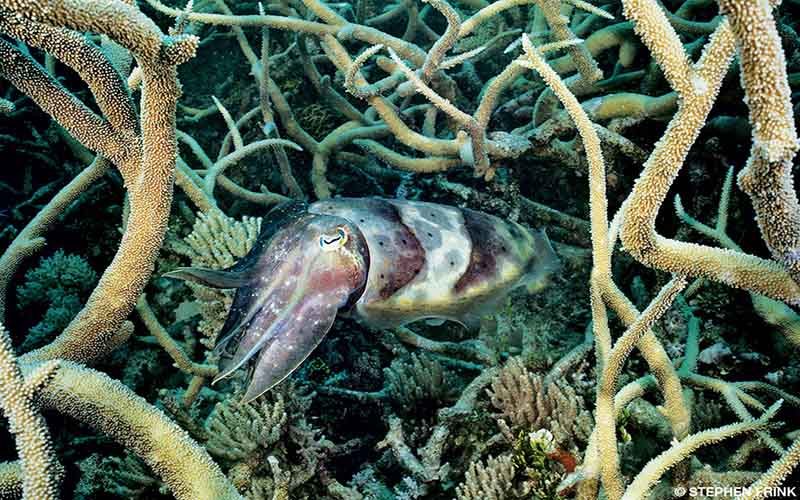
Next we moved on to dive The Big Woody. The site’s etymology was left to our imaginations, but it is likely related to nearby Wood Reef. I found this site excellent for smaller critters, clownfish in particular, and the night dive was outstanding here as well.
The last site we visited, Nature’s Bounty, rewarded us with pristine staghorns, which we had come to expect, and it was also home to numerous cuttlefish. From my previous trip I recalled watching cuttlefish laying their eggs amid the protection of the antler corals. I did not witness that particular behavior this trip, but Nature’s Bounty featured the kind of coral cover they seemed to gravitate toward when laying eggs.
We ended our trip at Lockhart River, an aboriginal shire on the Cape York Peninsula. For us, Lockhart was more of a travel necessity than an attraction, though its beaches were truly extraordinary. Wandering these beaches, killing time while waiting for the flight back to Cairns, I pondered the resilience of the ocean. I believe the scientists who sounded the alarm about climate change and the hazard of coral bleaching in too warm seas. But I was inspired to see an ecosystem so completely recovered that the corals and anemone were not only astonishingly intact but also spawning. It is all about water quality. Given a chance, Mother Ocean will provide the habitat for fish and coral to flourish. To my great delight, rumors of the untimely death of the Great Barrier Reef were greatly exaggerated.
How to Dive It
Getting there: Besides being the gateway to Australia’s far north, Cairns is itself a great dive destination. There are no direct flights to Cairns from North America, but the connecting flights within Australia are frequent and painless. Be aware of the weight restrictions on hand-carry items for domestic air travel. If you are simply in transit to Cairns, you are subject to the more generous international weight allowances for hand-carried luggage, but if you were to spend time in Sydney, for example, before flying to Cairns, you would be restricted to two bags weighing no more than 15 pounds each — and restrictions may vary by airline. That is tough for underwater photographers who wish to hand-carry fragile gear. So if you plan to travel within Australia, you might wish to invest in hard luggage in which you can check your photo gear — or figure out a way to travel light.
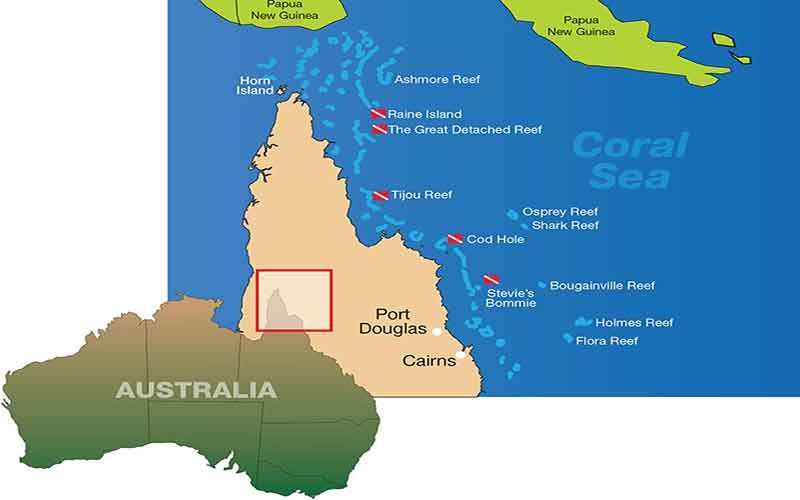
On shore: Cairns is rich with topside attractions, including an extensive rainforest and activities such as hot-air ballooning, helicopter rides over the Great Barrier Reef and the new Cairns Aquarium downtown. There are great restaurants, hotels and even a casino.
Conditions: The far-north expedition is by liveaboard dive boat by necessity, given the distances involved. One should be comfortable with the liveaboard lifestyle and, if subject to motion sickness, pack appropriate medication. October and November are the traditionally optimal months for far-north expeditions. The water temperature that time of year is typically between 79°F and 82°F, and visibility is in the 60- to 90-foot range. Visibility at some sites, such as those around Turmoil Bay, could be greater than 100 feet. We rarely experienced excessive current, but that can vary with the lunar phase and tidal conditions. None of the dives we did needed to be deeper than 100 feet, and most involved multilevel ascents into shallow coral gardens. The diving was benign, albeit remote. While our tour departed Cairns and returned to Lockhart River for a commuter flight back to Cairns, trips in 2018 will utilize the gateways Cairns and Horn Island in the York Peninsula for one-way cruise itineraries.
| © Alert Diver — Q1 2018 |